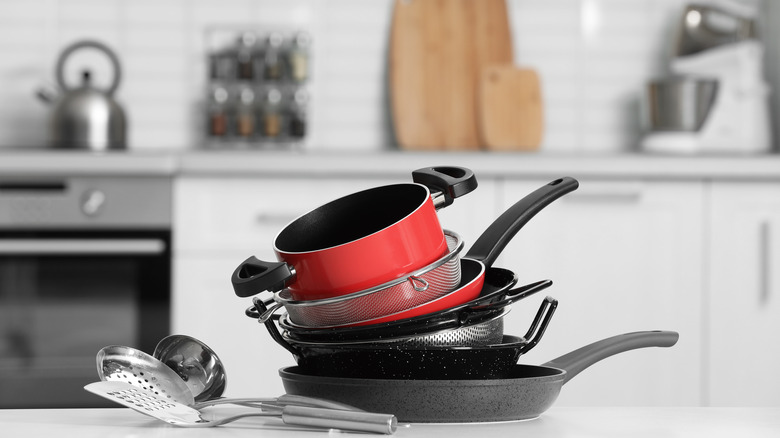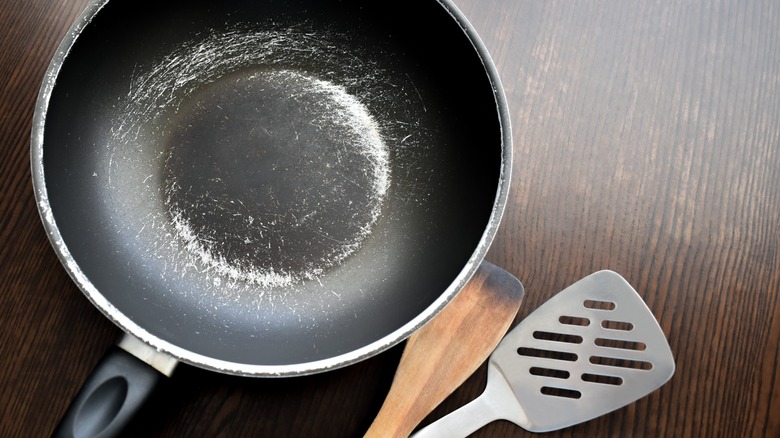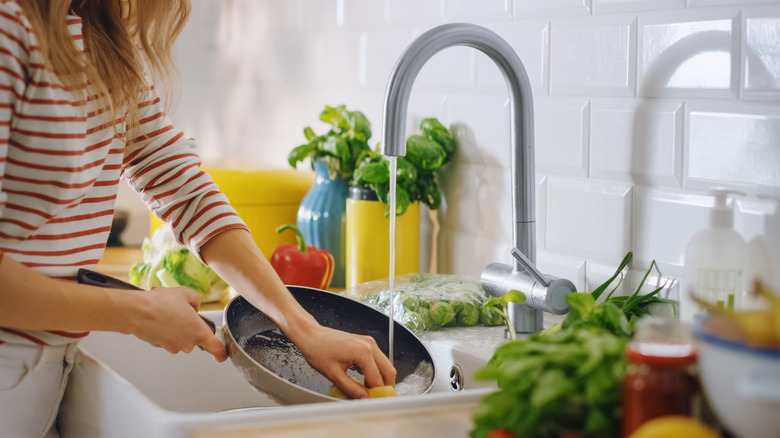Why You Should Avoid Using Magic Erasers On Nonstick Cookware
Magic erasers make cleaning a breeze, but you can't use them on everything in your home. Nonstick cookware is just one of the items you shouldn't wash with this type of cleaning product. While it may feel soft and squishy like a typical dish sponge, it actually works like sandpaper. You can use magic erasers on any items and surfaces that won't become damaged by the rough texture. However, when nonstick cookware is scraped with this tool instead of a regular sponge, the coating chips away and ends up in your food.
Magic erasers are made from melamine foam that is cured into a resin. This process makes the open-cell microstructure hard enough to scrap dirt and stains off the surfaces in your home. It's safe to use magic erasers on walls, floors, outdoor furniture, and items that are made from plastic, metal, leather, or vinyl. In fact, it's okay to clean almost all hard surfaces with melamine foam, but you should always do a test patch before wiping down the entire object.
Scratching the nonstick coating is dangerous
Nonstick cookware is made by adding a coating that prevents food from getting stuck. Until 2006, this included the carcinogenic chemical compound PFOA. The Environmental Protection Agency banned it because when you scratch the coating, pieces are left in the food you're eating and in the water that goes down your drain. You want to avoid using magic erasers because they are abrasive and leave scratches all over your nonstick cookware, potentially releasing carcinogenic chemicals.
According to the EPA, eating food with this coating puts you and your family at risk of developing kidney, liver, pancreatic, and testicular cancer. You can also suffer from other ailments like high cholesterol, thyroid hormone disruption, ulcerative colitis, elevated liver enzymes, and pregnancy-induced hypertension and preeclampsia. Furthermore, when you wash these pots and pans, the PFOAs are going down your drain to harm the environment.
Modern nonstick cookware is made from PTFE, also known as Teflon. While it is a non-toxic solution, you still shouldn't use magic erasers to clean cookware with this coating. Using melamine foam will scratch your pots and pans, meaning you'll have to replace them sooner than expected.
How to clean nonstick cookware without damaging it
You don't need magic erasers to clean your nonstick cookware effectively. Instead, you can get the job done with dish soap, a sponge, and some old-fashioned elbow grease. After cooking, you should always wait for your pots and pans to cool before washing them. Otherwise, the shock of cold water can warp them. A cellulose sponge is excellent, or you can use any other soft sponge or cloth.
To wash your nonstick cookware, scrub all the food residue off before rinsing it with water. Don't forget to clean the bottom sides and the handles. If you have difficulty removing any burnt-on food, don't continue to scrape it off with your hands. Instead, fill the pot or pan almost all the way with water. Then pour ½ cup of distilled white vinegar into it and place it on your stovetop. Once it comes to a boil, turn off the heat and let the water cool, you can then finish cleaning it with dish soap and a soft sponge.


